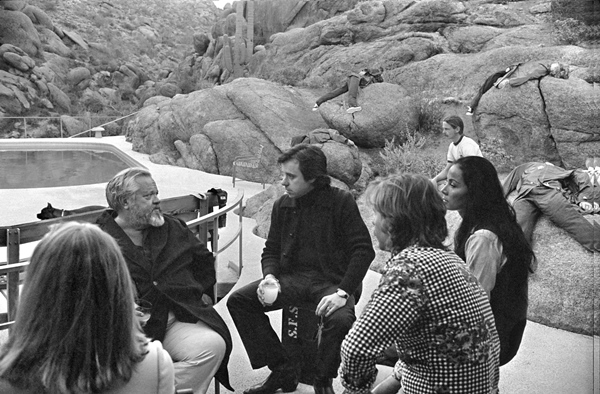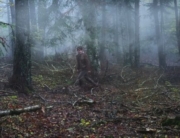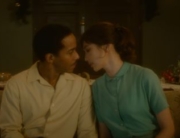An Orson Welles movie released in 2018! More than 40 years after it began production, the director’s last and unfinished project has finally been completed and paid for by Netflix. The Other Side of the Wind is no longer the stuff of Hollywood folklore, thanks to an excellent team effort headed by editor Bob Murawski. (The stories around this cursed project are infamous and retold in Morgan Neville’s engaging documentary They’ll Love Me When I’m Dead, also available on Netflix.) Supposedly it was going to be a comeback film for Welles in Hollywood, but it took years and years to finish the production and more than 100 hours of footage to edit. He died in 1985.
The “new” old film is a product of its time, with the aesthetic and the free spirit of 1970’s moviemaking. It would have been impossible for it to have been made in any other decade. At first, it’s presented as a mockumentary of the last day in the life of notorious filmmaker Jake Hannaford, played with delightful malice and fury by the one and only John Huston. The events are largely portrayed during a party, a microcosm of Hollywood, where part of Hannaford’s latest and still unfinished film will be projected—a case of art imitating life.
Hannaford might be seen as Welles’s alter ego, or Huston’s, but it is basically a classic archetype of a selfish, misogynist, and despotic male artist surrounded by minions who admire the director just as much as they secretly hate him. One of his followers is Brooks Otterlake, played by another famous director and screenwriter, Peter Bogdanovich. Other characters are like a Greek choir, made up of actors, reporters, and snobby film buffs. Prominent actors in the cast include Susan Strasberg as a film critic, á la Pauline Kael; Mercedes McCambridge as Hannaford’s editor; and Lilli Palmer as a former actress who hosts the party.
The movie blends scenes from the party with footage of Hannaford’s film within the film, starring an actress (Oja Kodar, the real-life partner of Welles and co-writer of the film) and Oscar “John” Dale (Bob Random), who was discovered by Hannaford on his last vacation where he saved the boy from an attempt of suicide. This “actor” disappears with no explanation before the shooting is completed. This is one of the reasons why Hannaford’s movie has been suspended (also because the director needs money to complete it).
The eye of the camera is explicitly intrusive and always moving. The black-and-white party scenes are shot from a different range of formats and from many points of view: every member of the press seems to carry a 16mm camera. The sequences of the film directed by Hannaford are in color, with a sensuous desert look, entirely made of shots imbued in mystery and eroticism. They are ironically and purposefully influenced by European filmmakers like Godard and Antonioni. Every frame and camera movement, highlighted with quick and energetic cuts, is a reminder throughout of the never-ending “muscular” power of Welles’s craft. You can almost sense how his filmmaking technique is always flexing to create feelings and effects that enlarge the story, dialogue, and acting. You understand again why this is the same man who gave us Citizen Kane, often considered the “best film of all time.” His footprint never gets old.
The party guests hold fragmented discussions on different and compelling subjects: auteur cinema pretensions, the objectification of women, and the repressed homosexual impulses of straight male artists (a subtext that can be read in Hannaford’s obsession with John Dale). However, many of the clever inside jokes at the party now seem on-the-nose.
The Other Side of the Wind is a lucid, delayed revenge against Hollywood that lives up to the hype. Sadly it doesn’t matter much if it will be considered a great film rescued from the ashes (as an excellent swan song in Welles filmography, if you will) or another curiosity for film lovers. In the end, Netflix has the last laugh for gaining more prestige with this kind of heavily publicized project. However, it deprives the movie from a conventional release in theaters, except for a handful of screens nationwide, and the movie may remain mainly unnoticed by most of platform’s subscribers. That would be a cruel and unfair ultimate fate for a beautifully crafted lost film that almost never existed.

















Leave A Comment